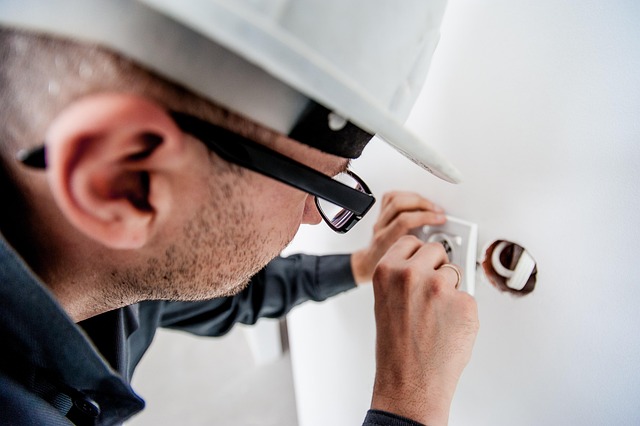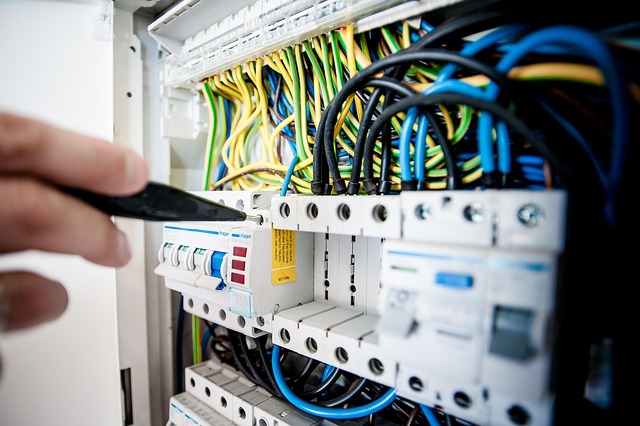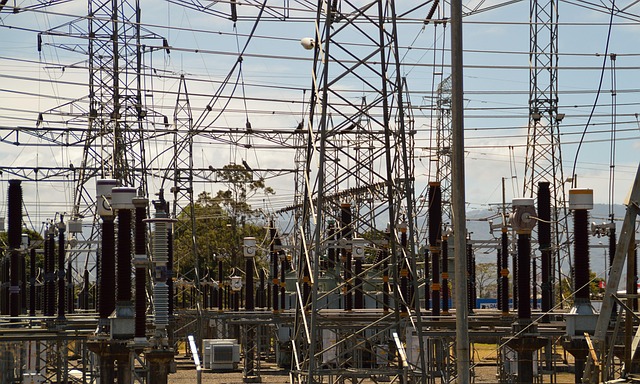Regularly inspect switches, receptacles, and outlets for damage. Use specialized tools to test voltage, current, and resistance. Replace outdated components if severe damage or safety concerns exist. Equip with essential tools like wire strippers, pliers, and a multimeter. Isolate power using circuit breakers and fuses before repairs. Follow steps: identify issues, isolate problem area, remove old parts, test wires, rewire new parts, test repairs, activate breaker. Common causes of problems include faulty wiring, loose connections, wear and tear. Regular inspection, maintenance, and surge protectors extend lifespan. Consult a qualified electrician for expert care.
“As a professional electrician, you often encounter faulty switches, receptacles, and outlets—common issues that can disrupt any home or business. This comprehensive guide delves into identifying these problems, repairing vs. replacing components, and essential safety precautions. Learn the steps to efficiently fix or replace these elements, from gathering the right tools to long-term maintenance tips. Optimize your electrical work with this expert advice tailored for electricians.”
- Identifying Faulty Switches, Receptacles, and Outlets
- Repair vs Replace: When to Choose Each Option
- Tools and Safety Precautions for Electricians
- Step-by-Step Guide to Repairs and Replacements
- Common Issues and Long-Term Maintenance Tips
Identifying Faulty Switches, Receptacles, and Outlets

Identifying faulty switches, receptacles, and outlets is a crucial task for both homeowners and electricians. Regularly inspect your home’s electrical system to spot any signs of damage, such as burning odours, warmth when touched, or flickering lights, which could indicate a problem with these components. A professional electrician can also help in identifying issues that may not be immediately apparent, using specialized tools to test voltage, current, and resistance.
During an inspection, look for physical damage like burns, scorch marks, or signs of overheating. Loose connections, corroded terminals, or discoloured wiring are additional indicators of potential problems. An electrician should also check for proper grounding and bonding to ensure the safety and reliability of your electrical system.
Repair vs Replace: When to Choose Each Option

When deciding between repairing or replacing switches, receptacles, and outlets, it’s crucial to consider several factors. A qualified electrician can often repair these components if they’re in good condition but showing minor issues like loose connections or faulty switches. Repairs are generally more cost-effective and eco-friendly, as they extend the lifespan of existing hardware.
However, if a component is severely damaged, outdated, or doesn’t meet current safety standards, replacement might be the better option. Electricians can install new, up-to-code fixtures that enhance safety and functionality. While replacements may have a higher upfront cost, they ensure a more reliable electrical system and potentially save on future repairs or hazards.
Tools and Safety Precautions for Electricians

Before tackling any electrical repairs or replacements, Electricians should equip themselves with the right tools for the job. This typically includes voltage testers, wire strippers, pliers, screwdrivers, and a multimeter—essential tools for ensuring accurate measurements and safe disassembly/reassembly. Safety is paramount; always wear insulated gloves and safety glasses to protect against electrical hazards. Familiarize yourself with circuit breakers and fuses, understanding how to isolate power to specific circuits when necessary. Know the location of your main electrical panel and practice diligent safety protocols, such as turning off the main power before any work begins. These precautions ensure both the electrician’s well-being and the reliable functionality of electrical systems.
Step-by-Step Guide to Repairs and Replacements

Repairs or replacements for switches, receptacles, and outlets are common tasks for any electrician. Here’s a straightforward guide to ensure you tackle these jobs effectively. Start by identifying the issue—is it a flickering light switch, a faulty outlet that won’t power your devices, or a worn-out receptacle? Once identified, turn off the relevant circuit breaker to isolate the problem area and prevent any accidents.
Next, gather the necessary tools: wire strippers, voltage tester, new switches, receptacles, or outlets compatible with your electrical system. Carefully remove the old component by unscrewing it from the wall plate and disconnecting the wires. Use a voltage tester to ensure no live wires are attached before proceeding. Re-wire the new part according to manufacturer instructions, ensuring proper connections for safety. Test the repair by turning on the circuit breaker and checking if the fixture or outlet functions correctly.
Common Issues and Long-Term Maintenance Tips

Common issues with switches, receptacles, and outlets include frequent tripping, burning smells, overheating, and non-functioning components. These problems often stem from faulty wiring, loose connections, or wear and tear over time. An electrician can diagnose and address these issues, ensuring the safety of your home’s electrical system.
To prevent long-term maintenance problems, regular inspection and upkeep are essential. This includes checking for signs of damage or corrosion, tightening connections, and replacing outdated or damaged components. Using surge protectors and avoiding overloading outlets can also significantly extend the lifespan of these electrical elements, reducing the likelihood of future repairs.
When it comes to maintaining your home’s electrical system, repairs or replacements of switches, receptacles, and outlets are essential tasks for any homeowner. By understanding common issues and knowing when to seek professional help, you can ensure a safe and efficient electrical environment. Remember, an electrician is always your best resource for complex jobs. With the right tools, safety precautions, and guidance from our step-by-step guide, tackling these repairs yourself or hiring a pro becomes more manageable. Regular maintenance, as discussed in this article, can prevent costly future issues. So, whether you choose to repair or replace, stay informed and keep your home’s electrical system in top shape.
